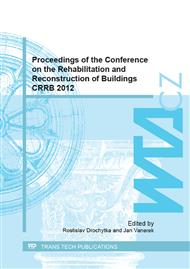p.172
p.176
p.180
p.185
p.193
p.201
p.207
p.213
p.222
Physico-Mechanical Properties of the Threshold Coupling Made of Secondary Raw Materials for Use in the Rehabilitation and Reconstruction of Buildings
Abstract:
The paper deals with physico-mechanical properties of the threshold coupling made of secondary raw materials, which could be used not only at newly built houses, but also at the rehabilitation and reconstruction work of existing buildings. The current trend in the use of secondary raw materials, constantly growing demands to reduce the overall energy performance of buildings and the elimination of thermal bridges both in the design phase and in the implementation phase, helps solve a new element of the threshold coupling, combining the above mentioned requirements for construction. The threshold coupling is inserted in the form of plates under the frame fills of building holes which borders between the exterior and interior of the building. The variability is in the possibility of height and longitudinal adjustment to the exact size and a greater range of boards with several kinds of geometrical modifications allowing waterproof termination of waterproofing made of the commonly used materials.
Info:
Periodical:
Pages:
193-198
Citation:
Online since:
May 2013
Authors:
Price:
Сopyright:
© 2013 Trans Tech Publications Ltd. All Rights Reserved
Share:
Citation:


